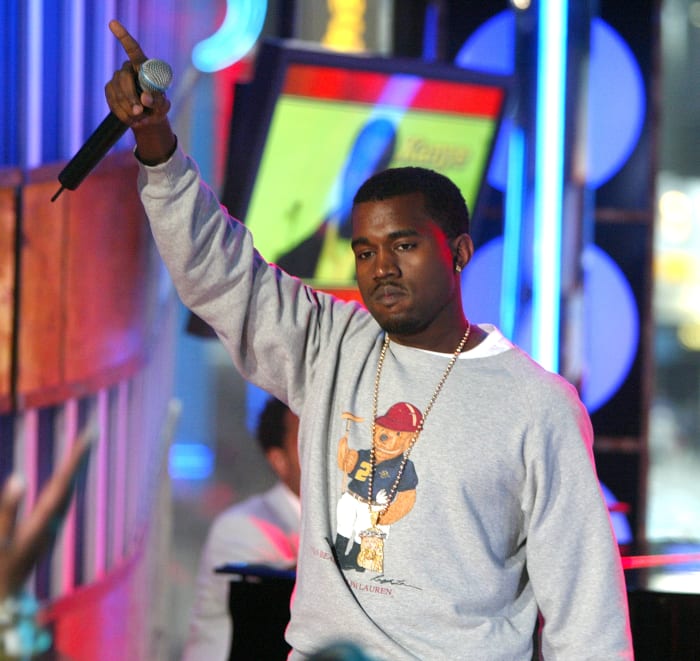The bear is adorable and who couldn’t resist buying it for their loved ones or buying for oneself.
HOW THE RALPH LAUREN POLO BEAR BECAME AN ICONIC HIP-HOP SYMBOL

Rapper Kanye West wears a Polo Bear sweatshirt on stage during MTV’s “Total Request Live” in 2004. Photo: Scott Gries/Getty Images
Ralph Lauren, hailed by many as the godfather of prep, built an empire on selling the American dream and the clothing to accompany it. But this isn’t about his origin story, or the creation of Polo Ralph Lauren (1967), or how his most famous logo — the polo rider — came to be (1972). It’s about the adorable and impeccably dressed Polo Bear that, since his birth in 1991, went on to capture the hearts of infants, mothers and grandparents — and the hip-hop community.
Maybe those who are deeply entrenched in the world of hip-hop understand how major of a role the bear plays in streetwear, but I wasn’t one of those people; thankfully, my husband is. When we took a trip up to Harlem to browse a few stores, I noticed a pattern: merchandising walls dedicated to Ralph Lauren, with the Polo Bear sweaters prominently on display everywhere. “The Polo Bear sweater is so cool, I want one,” he remarked. But, why? “It’s iconic,” he stated, matter of fact.
“Polo is really popular — it’s more popular than Jordans,” says an assistant manager at streetwear store Jimmy Jazz‘s Harlem location, who claims the bears are more popular than the horses. “We had a Polo event a few months ago with vintage Polo clothing from 1992, and it sold out. Everybody likes Polo; we sell at least one piece of Polo every day.”
The bear has always found success, beginning from when it was first conceived. Legend has it that Ralph’s brother Jerry was an avid collector of the Steiff teddy bear, so much so that one year, both were given bears dressed in their likeness, and it became something of a tradition. And then, in 1991, Ralph introduced a teddy bear — only 200 were made — and it immediately sold out that weekend. Soon thereafter, the bear was found knitted on sweaters, stamped on tees and embroidered on shirts.
One group in particular immediately saw its potential: the Lo-Life Crew, the Brooklyn-based gang notorious for stealing Ralph Lauren merchandise in the ’80s and ’90s. Rack-Lo, one of its founders and the holder of many titles, including author, designer of RL Jewelry, entrepreneur and artist, says the Polo Bear is special; that, after the horse, it’s the brand’s most famous symbol.
At 15 years old, Rack-Lo formed the Lo-Lifes in 1988 to unite the crews from Brownville and Crown Heights and create a 100-member force that embodied the hip-hop lifestyle. The only criterion? To live and breathe Polo Ralph Lauren.
“We focused on Polo and made it our signature brand, and for us, when we first started wearing it, it was seen as exclusive, something that you didn’t see in the ghetto; it wasn’t worn by people who lived in our community,” says Rack-Lo. “Polo was made for the rich, WASP-y kids; it wasn’t made for urban kids, and as teenagers, we couldn’t afford it. My mom never went to college, my father worked various jobs to take care of the family, so we had to find other means to get our hands on it.”
By “other means,” it meant running into stores — any retailer that carried Polo, like the Polo Mansion on Madison Avenue, Bergdorf Goodman, Saks Fifth Avenue, Bloomingdale’s or Barneys, was a target — grabbing as much as they could, and bringing it back to Brooklyn. There were, of course, consequences. Some were incarcerated, others were maimed, and in some instances, per Rack-Lo, people lost their lives. But he says that was the price to pay to live that kind of lifestyle.